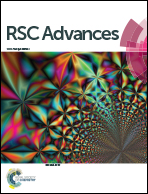The effect of fluorination on the surface structure of truxenones†
Abstract
The surface structure of partially fluorinated truxenone (F3-truxenone) molecules on Cu (111) has been probed using a combination of scanning tunneling microscopy (STM) and low energy electron diffraction (LEED). Codeposition of F3-truxenone and the parent truxenone molecule leads to a mix of discrete F3-truxenone and truxenone islands on a Cu (111) surface. Due to the differences in rotational orientation of each type of molecular island proved by LEED the otherwise indistiguishable molecules can be identified in STM images.



 Please wait while we load your content...
Please wait while we load your content...